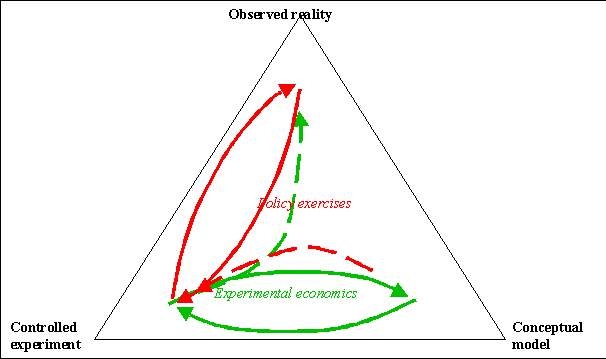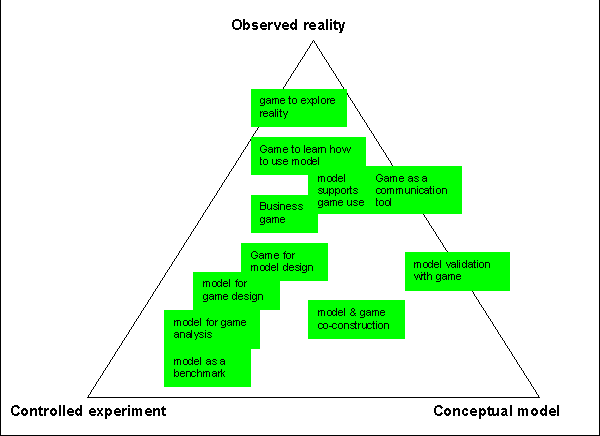Olivier Barreteau (2003)
The joint use of role-playing games and models regarding negotiation processes: characterization of associations
Journal of Artificial Societies and Social Simulation
vol. 6, no. 2
To cite articles published in the Journal of Artificial Societies and Social Simulation, please reference the above information and include paragraph numbers if necessary
<https://www.jasss.org/6/2/3.html>
Received: 8-Mar-2003 Accepted: 17-Mar-2003 Published: 31-Mar-2003
Experimental economics implements a conceptual model in a controlled experiment in order to understand features of an observed reality.Policy exercises use background conceptual models in a controlled experiment with stakeholders of an observed reality.

|
| Figure 1. Paths of policy exercises and experimental economics in triangle {Observed reality, controlled experiment, conceptual model} |
| Table 1: classification of the categories of joint use of a computerized model and a RPG according to the sharing of conceptual model and the relative timing of use | |||||
| different underlying conceptual models | same underlying conceptual model | ||||
| model and game are used within parallel processing | |||||
| model and game are used one after the other | |||||

|
| Figure 2. Position of the various associations in the triangle (observed reality, controlled experiment, conceptual model). |
2 as implemented in an unpublished work by Philippe Legrusse and collaborators
AUBERT S, LE PAGE C, JOLY H, RAZAFINDRABE R, RANAIVOSON J F, RALALAOHERIVONY S B, N'DIAYE I C and BAIN D (2002), "Conception, adaptation and diffusion of a computer-assisted role game about phytogenetic resources management at a rural level in Madagascar". Communication to ISEE'2002, Sousse, Tunisia.
BARRETEAU O and BOUSQUET F (1999). "Jeux de rôles et validation de systèmes multi-agents", In Gleizes M-P and Marcenac P (Eds.) Ingénierie des systèmes multi-agents, actes des 7èmes JFIADSMA:Hermès.
BARRETEAU O and BOUSQUET F (2001), "From a Conceptual Model to its Artifacts: Building on Experiments using the SHADOC Model". Communication to MODSIM'01,Canberra Modelling and Simulation Society of Australia and New Zealand.
BARRETEAUO, BOUSQUET F and ATTONATY J-M (2001) Role-playing games for opening the black box of multi-agent systems: method and teachings of its application to Senegal River Valley irrigated systems. Journal of artificial societies and social simulations, 4. https://www.jasss.org/4/2/5.html.
BENBASAT I and LIM J (2000) Information technology support for debiasing group judgments: an empirical evaluation. Organizational behavior and human decision processes, 83. pp. 167-183.
BOUSQUET F, BARRETEAU O, D'AQUINO P, ETIENNE M, BOISSAU S, AUBERTt S, LE PAGE C, BABIN D and CASTELLA J-C (2002). "Multi-agent systems and role games : an approach for ecosystem co-management." In Janssen M (Ed.) Complexity and Ecosystem Management: The Theory and Practice of Multi-agent Approaches: Edward Elgar Publishers.
BOUSQUET F, BARRETEAU O, LE PAGE C, MULLON C and WEBER J (1999). "An environmental modelling approach. The use of multi-agent simulations", In Blasco F and Weill A (Eds.) Advances in environmental and ecological modelling:Elsevier.
BURKARDT N, LAMB B L and TAYLOR J G (1998) Desire to bargain and negotiation success: Lessons about the need to negotiate from six hydropower disputes. Environmental management,22. pp. 877-886.
BURTON M A (1989) Experiences with the irrigation management game. Irrigation and drainage systems,3. pp. 217-228.
CARDENASJ-C (2000), "Real wealth and experimental cooperation: evidence from field experiments". Communication to IASCP'2000,Bloomington.
COOPERD J, KAGEL J H, LO W and GU Q L (1999) Gaming against managers in incentive systems: experimental results with chinese students and chinese managers. The American Economic Review, 89. pp. 781-804.
DANIELSS E and WALKER G B (1996) Collaborative learning: improving public deliberation in ecosystem-based management. Environmental Impact Assessment Review,16. pp. 71-102.
D'AQUINO P, BARRETEAU O, ETIENNE M, BOISSAU S, AUBERT S, BOUSQUET F, LE PAGE C and DARÉ W (2002), "The Role Playing Games in an ABM participatory modeling process: outcomes from five different experiments carried out in the last five years". Communication to IEMSS, Lugano, June 24th-27th.
D'AQUINO P, LE PAGE C, BOUSQUET F and BAH A (2002), "Self-Designed Role-Playing Game and Multi-Agent System to Empower a Local Decision-Making Process on Land Use Management: the SelfCormas Experiment in Senegal". Communication to ISEE'2002,Sousse, 6-9 march 2002.
DARÉW and BARRETEAU O (2002) A role-playing game in irrigated system negotiation: between play and reality. Journal of Artificial Societies and Social Simulations, 6.
DORAN J E (1999). "Trajectories to complexity in artificial societies: rationality, belief and emotions", In Kohler T and Gummerman G (Eds.) Dynamics in human and primate societies: Oxford University Press.
DRIESSEN P P J, GLASBERGEN P and VERDAAS C (2001) Interactive policy making - a model of management for public works. European Journal of Operational Research,128. pp. 322-337.
DUFFY J (2001) Learning to speculate: experiments with artificial and real agents. Journal of Economic Dynamics and Control, 25. pp. 295-319.
DUIJN M and IMMERS L H (2003) Gaming Approach Route 26: a combination of computer simulation, design tools and social interaction. Journal of Artificial Societies and Social Simulations,6.
EDMONDS B (2003) The Design and Use of Integrated and Agent-Based Models for Freshwater Resource Management. WP3 Report. Firma Project. http://firma.cfpm.org.
ETIENNE M (2003) SYLVOPAST a multiple target role-playing game to assess negotiation processes in sylvopastoral management planning. Journal of Artificial Societies and Social Simulations, 6.
ETIENNE M, LE PAGE C and COHEN M (2003) A step by step approach to build up land management scenarios based on multiple viewpoints on multi-agent systems simulations. Journal of Artificial Societies and Social Simulations, 6.
FARATIN P, KLEIN M, SAYAME H and BAR-YAM Y (2001), "Simple Negotiating Agents in Complex Games: Emergent Equilibria and Dominance of Strategies, Seattle, USA, pp. 42--53". Communication to 8th Int Workshop on Agent Theories, Architectures and Languages (ATAL-01), Seattle (USA).
FORSSÉN M and HAHO P (2001) Participative development and training for business processes in industry: review of 88 simulation games. International Journal of Technology management,22. pp. 233-262.
FRIEDMAND and SUNDER S (1994) Experimental methods, a primer for economists.Cambridge University Press.
FRIEDMANN J (1987) Planning in the public domain: from knowledge to action.Princeton: Princeton University Press.
FUNTOWICZ S O, MATINEZ-ALIER J, MUNDA G and RAVETZ J R (1999) Information tools for environmental policy under conditions of complexity.Report N°9. European Environment Agency.
GARDINER P D and RITCHIE J M (1999) Project planning in a virtual world: information management or technology going too far? International Journal of Information Management,19. pp. 485-494.
GINTISH (2000) Beyond homo economicus: evidence from experimental economics. Ecological economics, 35. pp. 311-322.
GREEN K C (2002) Forecasting decisions in conflict situations: a comparison of game theory, role-playing and unaided judgment. International Journal of Forecasting, 18. pp. 321-344.
GROSZ B J (2000), "What's needed to Build Team Players". Communication to ICMAS'2000,Boston IEEE Computer society.
HÄMÄLÄINEN R P, KETTUNEN E, EHTAMO H and MARTUNEN M (2001) Evaluating a framework for multi-stakeholder decision support in water resources management. Group decision and negotiation,10. pp. 331-353.
HANNEMAN R A (1995) Simulation modeling and theoretical analysis in sociology. Sociological perspectives, 38. pp. 457-462.
HAREM, GILBERT N and PAHL-WOSTL C (2002), "An Internet-based Role Playing Game for Developing Stakeholders' Strategies for Sustainable Urban Water Management : Experiences and Comparisons with Face-to-Face Gaming". Communication to ISEE'2002,Sousse, 6-9 march 2002.
HARE M, HEEB J and PAHL-WOSTL C (2002), "The Symbiotic Relationship between Role Playing Games and Model Development: A case study in participatory model building and social learning for sustainable urban water management." Communication to ISEE'2002, Sousse, 6-9 march 2002.
HEATHCOTE I W (1998) Integrated watershed management, principles and practice.John Wiley & sons.
HENRICHJ, BOYD R, BOWLES S, CAMERER C, FEHR E, H. G and R. M E (2001) In Search of Homo Economicus: Behavioral Experiments in 15 Small-Scale Societies. American Economic Review, 91. pp. 73-78.
HUIZINGAJ (1951) Homo Ludens.Gallimard.
INNES J E and BOOHER D E (1999) Consensus building as role playing and bricolage: toward a theory of collaborative planning. Journal of the American Planning Association,65. pp. 9-26.
KIRMAN A P (1997). "The economy as an interactive system", In Arthur W B, Durlauf S N and Lane D A (Eds.) The economy as an evolving complex system II. Santa Fe: Addison Wesley.
KOHLER T A (1999). "Putting social sciences together again: an introduction to the volume", In Kohler T A and Gumerman G J (Eds.) Dynamics in human and primate societies: Santa Fe Institute.
LANSING J S (2002) 'Artificial societies' and the social sciences.Santa Fe Institute for Complex Studies. http://www.santafe.edu/sfi/publications/Working-Papers/02-03-011.pdf.
LEGAY J-M (1997) L'expérience et le modèle. Un discours sur la méthode.INRA éditions.
MAURIRAS-BOUSQUET M (1984) Théorie et pratique ludiques.Economica.
MEADOWS D and MEADOWS D (1993) Fish Banks news.Durham, NH, USA: Fish Banks limited and Laboratory for Interactive Learning University of New Hampshire.
MERMET L (1992) Stratégies pour la gestion de l'environnement, la nature comme jeu de société Paris: L'Harmattan.
MERMETL (1993) Une méthode de prospective : les exercices de simulation de politiques. Nature Sciences Sociétés,1. pp. 34-46.
MUCCHIELLI A (1983) Les jeux de rôles. Presses Universitaires de France.
OGIEN A (1997). "Forme et contenu du principe de publicité: Rawls, Habermas, Goffman", In Ion J and Peroni M (Eds.) Engagement public et position de la personne:Edition de l'Aube.
OSTROME (1992) Crafting institutions for self governing irrigation systems.San Francisco: ICS Press.
OSTROM E, GARDNER R and WALKER J (1994) Rules, games and common-pool resources.The University of Michigan Press.
PARENT M and GALLUPE R B (2001) The role of leadership in Group Support Systems failure. Group Decision and Negotiation,10. pp. 405-422.
PETERSV, VISSERS G and HEIJNE G (1998) The validity of games. Simulation and gaming,29. pp. 20-30.
PIVETEAU V (1995) Prospective et territoire : apports d'une réflexion sur le jeu. Cemagref éditions.
ROBINSON J B (1991) Modelling the interactions between human and natural systems. International social sciences journal, 130. pp. 629-647.
RÖLING N G and Jiggins J (1998). "The ecological knowledge system", In Röling N G and Wagemakers M A E (Eds.) Facilitating sustainable agriculture: Cambridge University Press.
SCHELLING T C (1961) Experimental games and bargaining theory. World politics,14. pp. 47-68.
SHAKUN M E (1996) Modeling and supporting task-oriented group processes: purposeful complex adaptive systems and evolutionary systems design. Group Decision and Negotiation, 5. pp. 305-317.
TOTH F L (1988) Policy exercises: objectives and design elements. Simulation and games, 19. pp. 235-255.
TSUCHIYAS (1998) Simulation/gaming as an essential enabler of organizational change. Simulation and gaming,29. pp. 400-408.
UBBELSA and VERHALLEN A (2000) Suitability of decision support tools for collaborative planning processes in water resources management.99.067 Report. RIZA.
VINCK D (1999) Les objets intermédiaires dans les réseaux de coopération scientifique. Revue Française de Sociologie, 40. pp. 385-414.
WATSON D R and SHARROCK W W (1990). "Realities in simulation/gaming", In Crookall D and Oxford R (Eds.) Simulations, gaming and language learning.New York: Newbury House Publishers.
WEBLER T, KASTENHOLZ H and RENN O (1995) Public participation in Impact Assessment: a social learning perspective. Environmental Impact Assessment Review, 15. pp. 443-463.
Return to Contents of this issue
© Copyright Journal of Artificial Societies and Social Simulation, [2003]